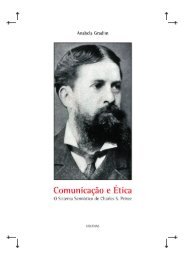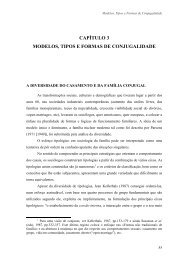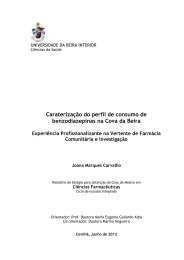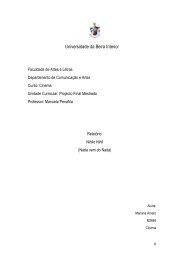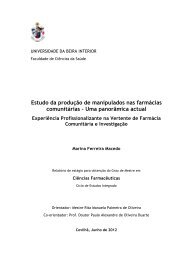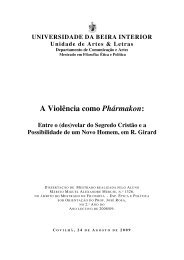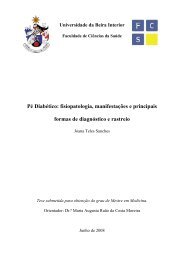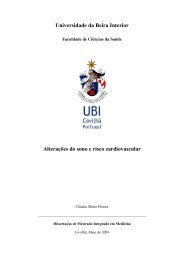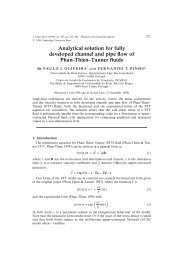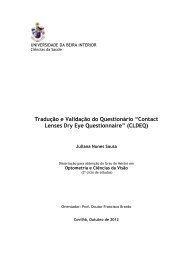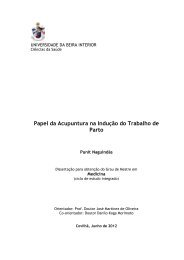Tese_Tânia Vieira.pdf - Ubi Thesis
Tese_Tânia Vieira.pdf - Ubi Thesis
Tese_Tânia Vieira.pdf - Ubi Thesis
Create successful ePaper yourself
Turn your PDF publications into a flip-book with our unique Google optimized e-Paper software.
Chapter III – Results and Discussion<br />
absorption depends on particles size, shape and the dielectric constant of the surrounding<br />
medium (Guzmán et al. 2009).<br />
In order to verify the concentration of AgNO 3 that produced the highest number of AgNPs,<br />
the absorption spectra of the AgNPs were obtained and are presented in Figure 9. All samples<br />
presented the characteristic surface plasmon of AgNPs (peak between 400 and 420 nm) with the<br />
exception of the spectrum of high concentrations (green line) where no AgNPs were produced. It<br />
was also observed that for lower concentrations (black line) the absorbance is reduced indicating<br />
the presence of few AgNPs. Such was also confirmed through SEM images. Based on these results,<br />
it was concluded that the intermediate concentration of AgNO 3 was the best to produce the<br />
AgNPs. Recently, it was reported by Martinez-Castanon that the absorption spectrum of spherical<br />
AgNPs present a maximum absorbance band between 420 and 450 nm with a blue or red shift<br />
with particle size decreasing or increasing, respectively (Martinez-Castanon et al. 2008). These<br />
observations showed that the reducing agent NaBH 4 produced smaller nanoparticles than that<br />
produced with C 6 H 8 O 6 . In the same study, Martinez-Castanon reported that the width of each<br />
plasmon is related to the size distribution. As referred above, large peaks indicate a large size<br />
distribution of nanoparticles, and for irregular particles (non spherical), two or more plasmon<br />
bands are expected depending on the symmetry of the particles (Martinez-Castanon et al. 2008).<br />
Therefore, the nanoparticles herein produced with C 6 H 8 O 6 were less uniform in their size and less<br />
symmetric compared to that produced, using NaBH 4 .<br />
The spectra of the samples obtained by UV-Vis spectroscopy are in agreement with those<br />
previously reported in literature (Kim et al. 2007; Guzmán et al. 2009; Vasilev et al. 2010;<br />
Guidelli et al. 2011). For instance, Kim and colleagues observed an absorption band at 391 nm<br />
for AgNPs (Kim et al. 2007). In the work of Guidelli and coworkers a characteristic absorption<br />
peak at 435 nm of AgNPs was observed (Guidelli et al. 2011). A study performed by Guzmán and<br />
collaborators demonstrated that the peak of the AgNPs was around 418 nm (Guzmán et al. 2009).<br />
Vasilev and collaborators observed a peak around 410 nm for AgNPs (Vasilev et al. 2010). In own<br />
study, an absorption peak around 400 nm was also observed, in accordance to previous studies.<br />
34



